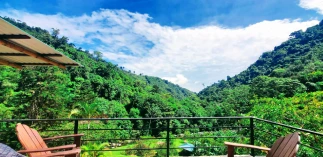While not a permanent resident, Costa Rica plays a vital role in the fascinating life cycle of the Kentucky Warbler. This vibrant songbird graces our mountain forests with its presence during the winter months, offering a fleeting glimpse of sunshine amidst the emerald undergrowth.
A Shy Songster
The Kentucky Warbler is a master of camouflage. Its bright yellow underparts and olive-green back blend seamlessly with the dappled light filtering through the forest canopy. Unlike its flamboyant relatives, the Kentucky Warbler prefers to stay hidden, flitting through the leaf litter on its long legs in search of insects. But don’t let its shy demeanor fool you. During breeding season further north, the male Kentucky Warbler transforms into a vocal powerhouse. Here in Costa Rica, however, their calls are reserved for the most part, with an occasional chip note being their only form of communication.
A Feast for the Ears
Despite their elusiveness, birders flock to Costa Rica during the winter hoping to catch a glimpse (or hear!) the Kentucky Warbler. Their song is a distinctive and delightful melody – a rapid series of two-parted notes, all delivered on the same pitch. It’s a surprisingly loud and complex song for such a small bird, often echoing through the quiet forest floor.
A Long and Arduous Journey
The Kentucky Warbler is a long-distance migrant. They breed in the eastern and central United States, venturing as far north as Wisconsin and Pennsylvania. Come fall, they embark on an incredible journey, flying non-stop across the Gulf of Mexico to reach their wintering grounds in the lush rainforests of Costa Rica and other parts of Central America and the Caribbean. This perilous migration highlights the incredible resilience and adaptability of these tiny birds.
Spotting a Kentucky Warbler
While seeing a Kentucky Warbler in Costa Rica can be a challenge, it’s not impossible! Here are some tips to increase your chances:
- Habitat: Look for them in dense, moist forests with a thick understory. They particularly favor areas near streams and with patches of sunlight filtering through the canopy.
- Time of Day: Early mornings are your best bet, as Kentucky Warblers tend to be more active during this time.
- Listen Closely: Their song is your best clue to their presence. Once you hear the tell-tale two-parted notes, patiently follow the sound and see if you can catch a glimpse of this shy songster flitting amongst the leaves.
A Transient Treasure
The Kentucky Warbler’s presence in Costa Rica is a fleeting but cherished part of our rich biodiversity. By protecting these vital forest habitats, we ensure that future generations can experience the magic of spotting this vibrant songbird flitting through the Costa Rican undergrowth.
For more information, please view our comprehensive guide about the birds of Costa Rica







